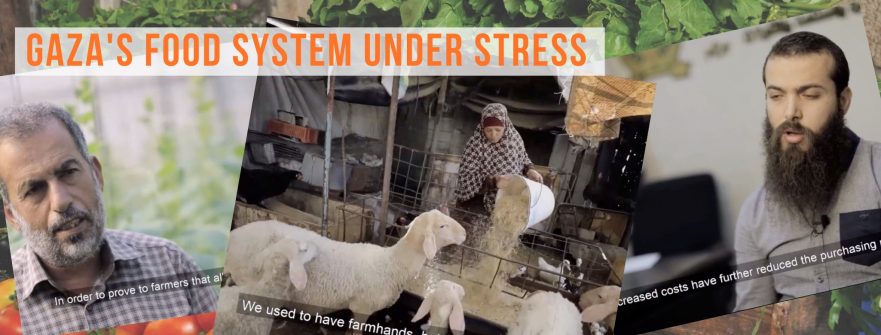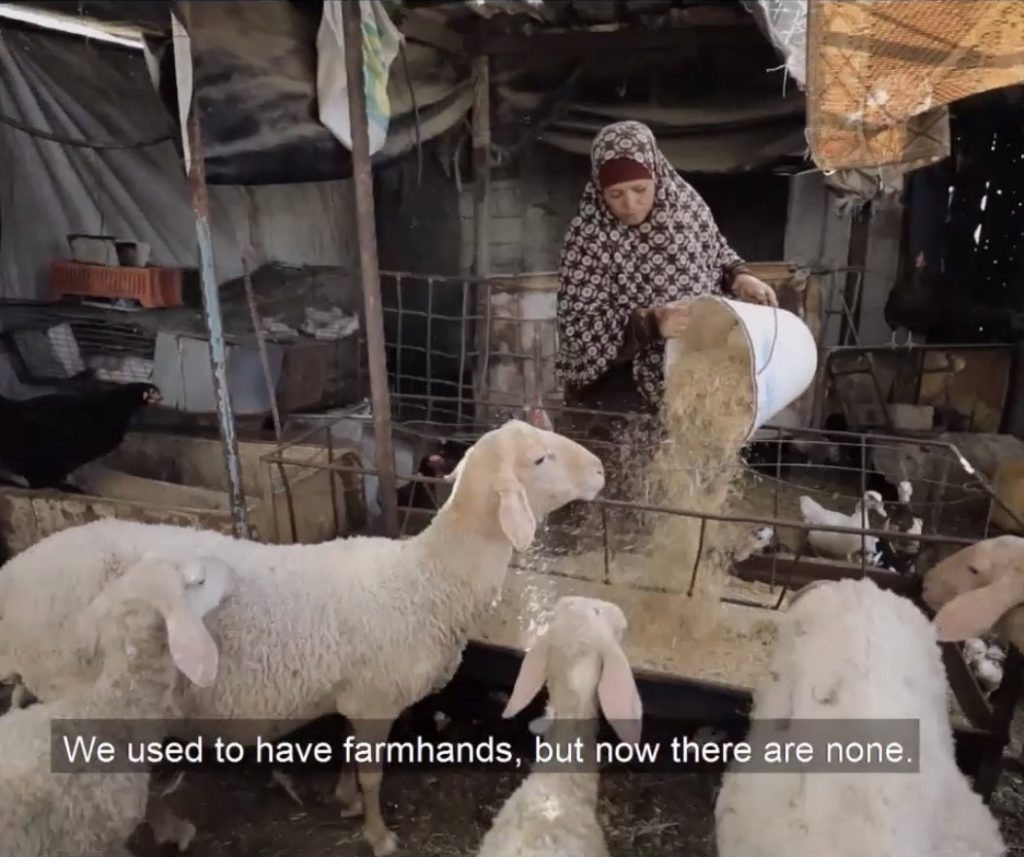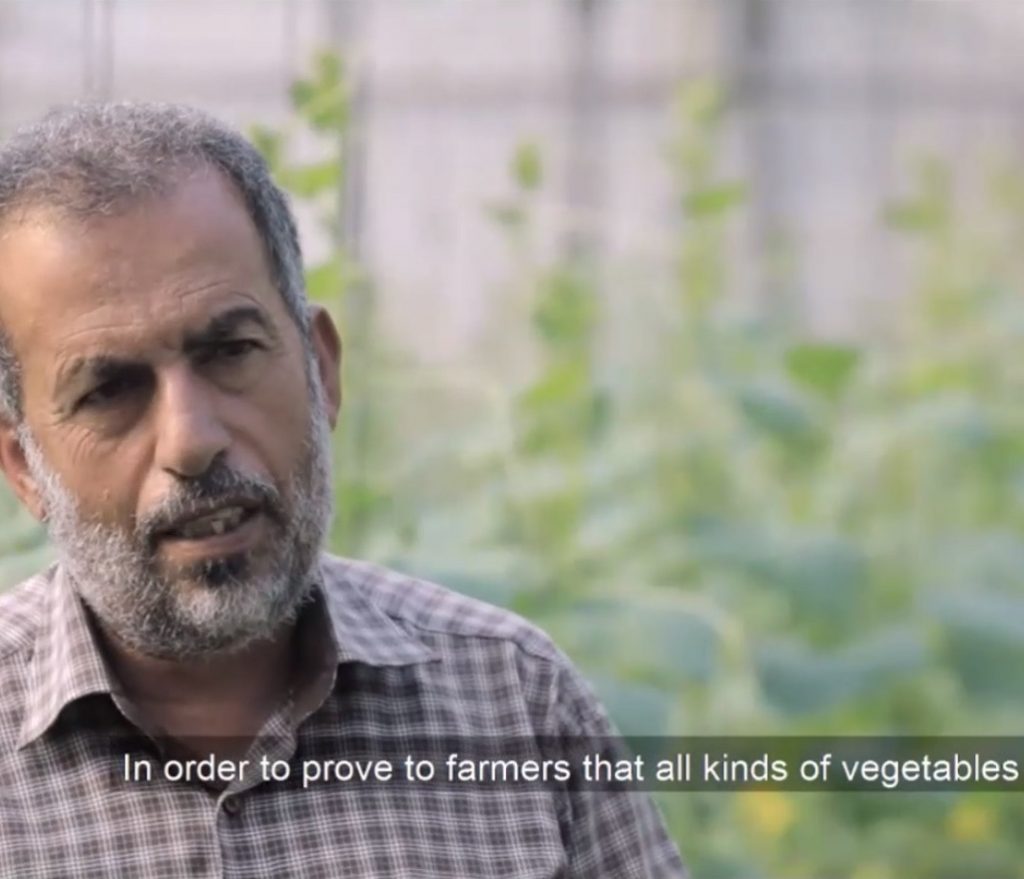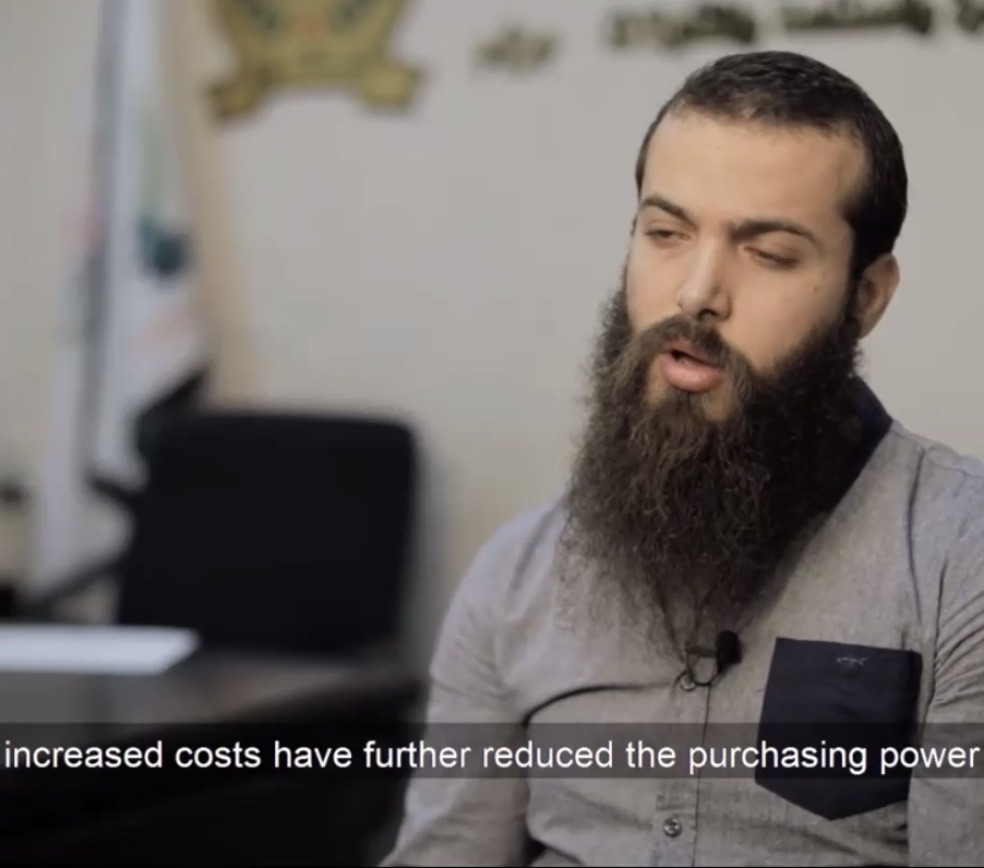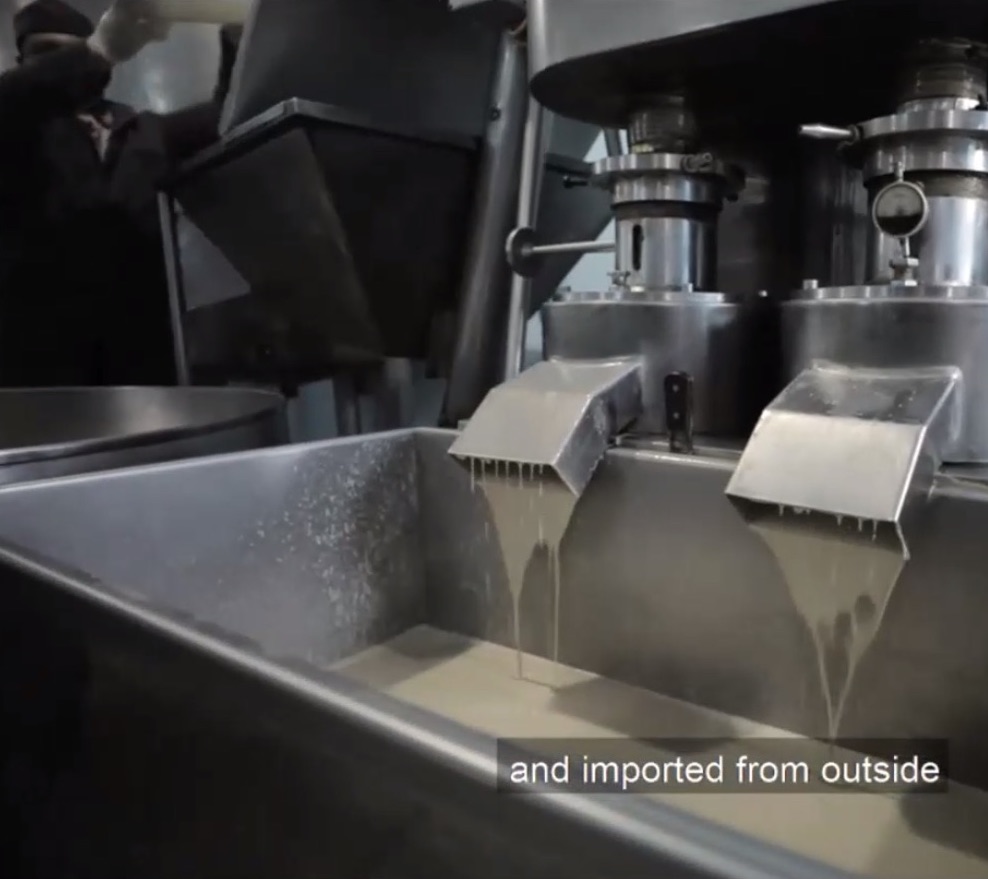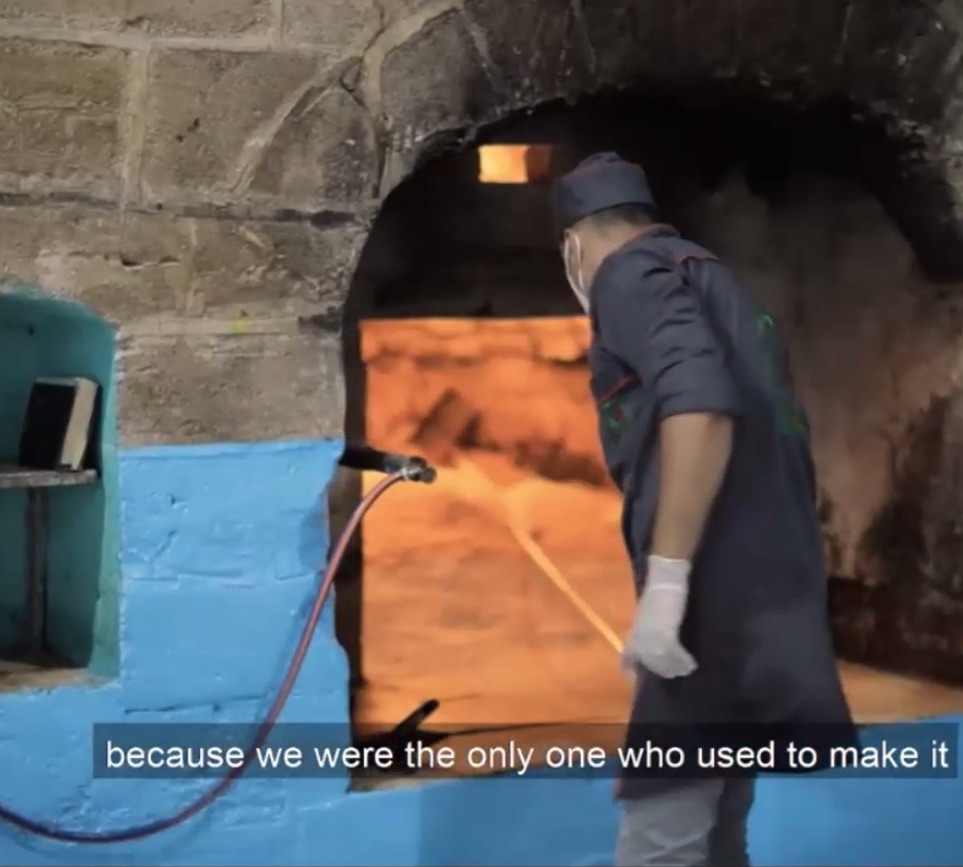On December 12, Just World Ed was pleased to release three short films (1, 2, 3), commissioned from Ain Media in Gaza, in which two farmers and a food-processing plant manager described their lives, the challenges they face in their work, and their aspirations– all in their own words, with English sub-titles and (optional) English voice-over.
These short films formed the heart of a broad-ranging discussion on the multiple stresses that Gaza’s food system faces, conducted by Laila El-Haddad and Maggie Schmitt, the authors of The Gaza Kitchen (which they describe as an “ethnographic cookbook”), and Mohammed Abujayyab, a Palestinian-American farmer and farming activist who in 2015 co-founded a farm/CSA in Bil’in, in the West Bank, and who farmed the last two seasons in Utah.
The conversation covered multiple, crucial themes, including the tragedy of the loss that hundreds of thousands of Palestinian fellahin (peasants) suffered, of their centuries-old traditions of land management and sustainable farming, when they were brutally pushed off their lands in the Nakba of 1948. (Around 80% of Gaza’s current population of 2 million are refugees from 1948, and their descendants.) The panelists discussed the difficulties of reclaiming even a small part of that accumulated wisdom in an environment in which decades-long dependency on international food aid of poor nutritional value has been accompanied by some efforts to encourage Palestinian farmers to engage in pesticides-heavy techniques that are “extractive” rather than sustainable over the long term.
This very content-rich and thought-provoking discussion can be viewed in its entirety here. It was moderated by Nora Barrows-Friedman of Electronic Intifada and was co-sponsored by the Washington DC-based Museum of the Palestinian People.
But first, the testimonies from within Gaza itself:
First up was Intisar al-Najjar, a women in her fifties (and mother of eleven) who inherited from her father a plot of land not far from the ghastly wall with which Israel has surrounded the Gaza Strip. This resilient and resourceful woman has been farming the plot for a little over a decade, raising some sheep and planting several different crops, including okra. In her video, she lamented the high cost of the water that she had to buy, in order to irrigate her land– at US$60 for each four-hour period she needed to do that. She could afford to do it, she said, only once a week, which harmed the productivity of her crops. Her main desire was to get access to electricity: she said that would allow her not only to pump water from her own well but also to help raise the sheep better– and also, to actually live on the farm, which she can’t presently do.
But go and watch the whole of her 5-minute video, to hear her speak for herself.
Next up was Abdulmonim Ahmed, one of the founders of the “Gaza Safe Agriculture Society” and a veteran advocate within Gaza of sustainable, organic farming practices. He appeared in the society’s fields and greenhouses, which appeared to be lushly green in contrast to the parched vistas over Ms. al-Najjar’s land. (The difference, it seemed, was his access to electricity and water.) Mr. Ahmed– who had made an earlier appearance in the pages of The Gaza Kitchen— spoke about the many health problems that arose from the widespread use of pesticides and chemical fertilizers, such as is inherent to what he termed “traditional” agriculture… by which, it seemed, he meant the kind of “modern”, commercially oriented agriculture practiced by, among many others in Gaza, Ms. al-Najjar.
Both farmers expressed great concern about the chronic lack of purchasing power among the mass of Gazans, which depressed the prices they could get for their products and which has gotten a lot worse during the long months of the Covid crisis. Mr. Ahmed reflected on his decade-plus of running organic farming projects inb Gaza and said that at the beginning there had been l,ittle understanding of what he was trying tom do but plenty of people able to buy his produce, while today, “the situation is reversed.” However, he concluded philosophically, “what we are primarily marketing is the idea of organic farming, not the product.”
His 5-minute film can be viewed here.
The third short film featured Abdulkarim Shakour, a manager in a tahina factory that had long been owned by his family. His major field is the “mechatronics” of the factory– keeping its many machines and their control systems in good working order. As the camera showed various stages in the process by which the Shakour Company transforms high stacks of sacks of imported sesame seeds into the tahina that dripped goopily into vast vats, Mr. Shakour talked about the lengthy frustrations he experiences trying to get permits for any spare parts that his machines need and the complexities of dealing with frequent power outages, the cost of running back-up generators, and so on. He also talked about his dream of being able to export the company’s range of products to markets outside the Gaza Strip– a dream that has run up against the reality of Israel’s total control and almost non-stop closure of the portals through which goods can enter or leave it.
See Mr. Shakour’s video here.
These videos proved a very informative jumping-off point for the discussions that followed.

The first panelist to speak was Mohammed Abujayyab. He described how he had grown up in the Mughazi refugee camp, descended from a peasant family forcibly displaced from its ancestral home and village in 1948. He explained how rich and multi-faceted the culture of the Palestinian fellahin had been, based as it was on the cycles of the growing season, the richness of the land, and the communal ways in which the villagers lived and worked. “It all has to do with access to the land,” he said. “But now, the Palestinians get to cultivate only very peripheral lands.” He noted that Ms. al-Najjab’s farm had butted up close to the Gaza enclosure wall– just as the land on which the Om Sleiman Farm he had started working in 2015, near Bil’in, also butted up against the Israeli Wall there.
Abujayyab described the Palestinian refugee camps as “locations of forced collective amnesia”, that denied their residents access to both the land and the heritage of the fellahin. As successive generations of refugees from Gaza went to work on as laborers on Israeli farms, he said, their attitude toward the land became more extractive. Referring to Mr. Ahmed’s organic farming venture and to what he himself and his colleagues had been attempting with the Om Sleiman Farm, he said, “We are trying to reclaim a more traditional and more regenerative relationship with the land.”
But the new generation, he added, “are seeing that this is not just about farming techniques but about the social and economic context in which they are practiced, such as the CSA [community-supported agriculture] model they used at Om Sleiman.” He concluded that, “Fighting back involves a certain amount of unlearning.”
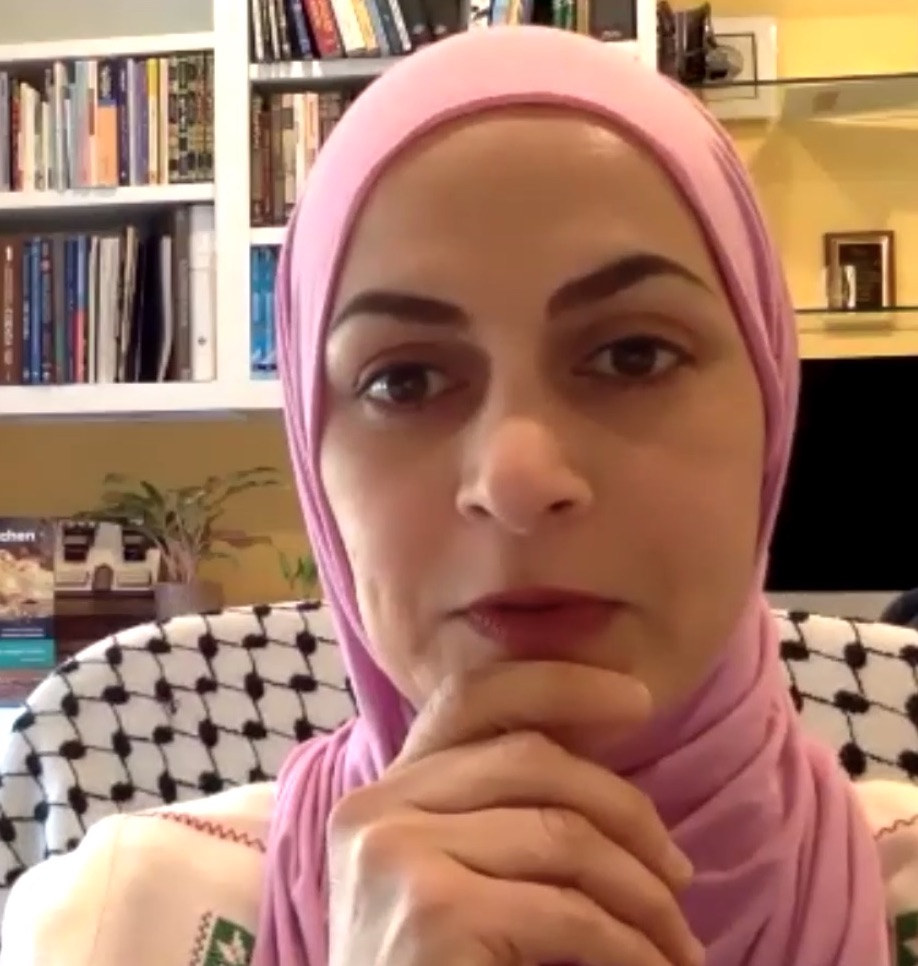
Next to speak was Laila El-Haddad, whose family are non-refugee Gaza Palestinians and who has authored another book in addition to The Gaza Kitchen (Gaza Mom) and numerous articles about life in Gaza. She lamented the extent to which the knowledge that Gazans had of their region’s rich traditional cuisine had decreased. She recalled that when she and Maggie Schmitt conducted their main research for The Gaza Kitchen in 2010 she had already found a worrying decrease– but when she went back to Gaza in late 2019 with a World Food Program delegation, the decrease in knowledge was worryingly greater.
El-Haddad underlined the many attacks the Israeli forces have undertaken against farmers and farmland, especially farmers like Intisar al-Najjab whose lands are located close to what Israel calls the “buffer zone”– actually, a broad strip of land inside Gaza where the Israelis frequently destroy crops or cut down trees. The stresses on farmers, she underlined, include both the constant physical threats that come from the IDF and the great uncertainty for all the farmers dependent on the “export permits” the Israelis can give or withhold, that are required if export-focused crops like strawberries or flowers are ever to reach their international markets.
She noted that Gazans’ access to fresh produce has also been radically reduced. “They get some form of animal protein maybe once a week, and fish maybe once a month– and this is not even local fish, but imported frozen Asian fish.”
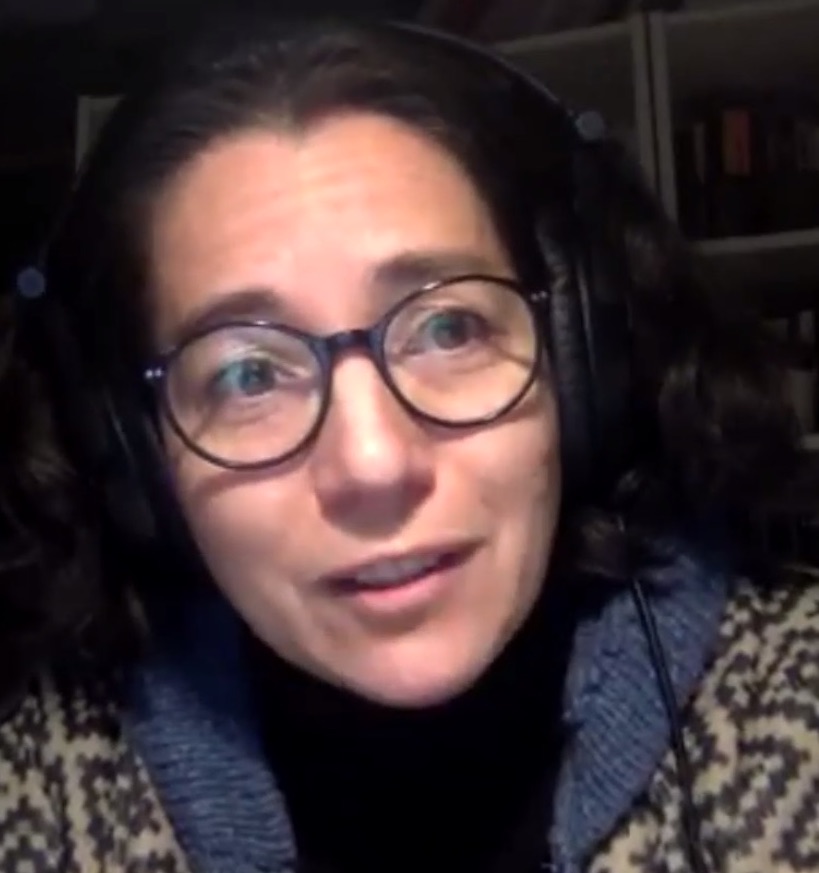
Maggie Schmitt, an anti-imperialist writer, researcher, and translator who had co-authored The Gaza Kitchen with El-Haddad and who currently lives in Spain, spoke next. She noted that Intisar al-Najjar would have learned the pesticide-spraying techniques that were depicted in her film “from the Ministry of Agriculture or from a series of NGOs that are training people mainly to grow cash crops for export.” She described this as a rupture from the self-sufficency model that Abujayyab had described existing in traditional society, noting that “This is not just in Gaza, but worldwide. But Gaza is so small and so vulnerable that you see the whole tempest in this teacup.”
“People have been trained over decades to produce cash crops for export,” she continued. “This has happened worldwide. But in Gaza, people have no sovereignty over whether these goods can ever be exported and can ever find a market.”
Schmitt identified a lack of sovereignty as also badly impacting the water-distribution system in Gaza. “Gaza is badly over-perforated with wells,” she noted. But since it does not receive nearly as much water as it needs coming into its aquifer from (functionally upstream) Israel, the greater the number of wells dug in the Strip, the more the seawater comes into the aquifer in especially the southwest, increasing its salinity.
She decried the extent to which Israeli policies had forced Palestinian farmers into forms of agriculture that leave them highly dependent on the Israeli authorities– though the Palestinians had previously had a rich history of rain-fed agriculture and conservation practices. She noted that — especially during the days of the “tunnel trade” with Egypt– Gaza had received numerous pesticides and other chemicals that had been banned as unsafe in other places.
Schmitt and El-Haddad both noted with sorrow the great loss of indigenous farming knowledge among Palestinians.
When the conversation turned to the tahina factory and its products, both El-Haddad and Abujayyab had powerful responses. “I found the sights and sounds of that so moving!” El-Haddad said. Abujayyab, by contrast, said, “It’s excruciating, honestly, to see sesame being imported from somewhere else.”
He gave a lengthy and rich disquisition on the role of sesame– its cultivation and its consumption– in the life of traditional, pre-Nakba Palestinian villages. He noted that the word tahina is the female form of tahin, which is flour, saying that demonstrated the centrality of the product in Palestinian culture. He recited a traditional ode to the glories and techniques of sesame cultivation; and he said that sesame oil (seerij) had been, along with ghee (semna), the two key oils that lay at the heart of traditional Palestinian cuisine– not olive oil, though that has now displaced seerij. He noted that annual seed, including oil-seeds, gave peasant farmers the ability to deal with their lack of perennial access to the land under traditional, more communal forms of landholding.
El-Haddad waxed lyrical about the glories of the specific red form of tahina that is unique to Gaza and which is an essential ingredient in some of the traditional Gazan dishes documented in The Gaza Kitchen. “When I went to Gaza in 2019, people were just buying a tiny amount of red tahini in a bag, to use in a specific dish,” she said.”They couldn’t even afford to keep a jar of it at home.”
She and Abujayyab discussed the contribution that tahina, other sesame by-products, and other products of traditional Palestinian farming used to make to providing good nutrition, and they lamented the effects that the longterm aid dependence induced by displacement had had on the Palestinian refugees’ wellbeing. Abujayyab noted that when his father had first come to the United States, he had osteoporosis, an effect of calcium deficiency that is extremely rare in men. He recalled that he himself had not drunk fresh milk before he came to the United States, noting that all that UNRWA provides is dried milk and over-refined white flour that leads to diabetes and other disorders. “You can’t invent environmental solutions for a political situation,” he concluded.
The discussion continued, touching on many other aspects of the effects that mass displacement, decades-long aid dependency, and Israel’s (also decades-long) control of Gaza and other parts of Palestine have had on Palestinians’ traditional foodways. Please do go and watch all of it– and look at all the other resources about food sovereignty challenges for Palestinians and others worldwide that we have on the “Beyond Survival” resource page on our website.
Just World Ed plans to resume this project in early spring 2021… and Just World Books plans to release a new Third Edition of The Gaza Kitchen in May 2021.

